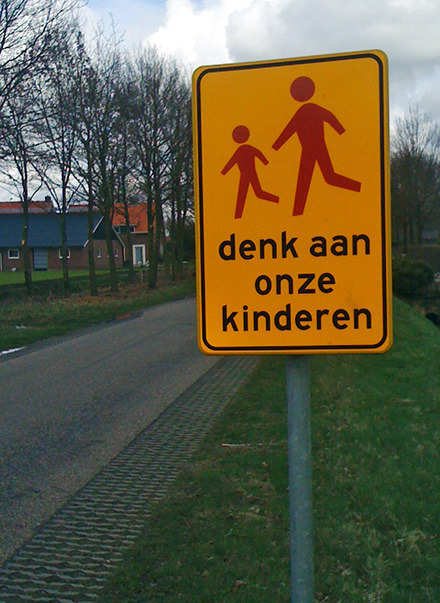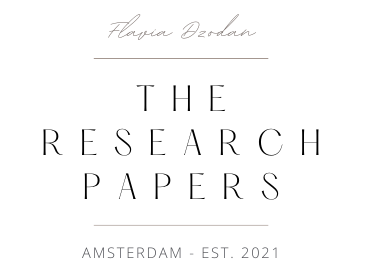On White Dutch people’s “feelings”, blackface, racism, lives worth cherishing

[Photo caption: a yellow sign with two silhouettes, next to a road, reads, in Dutch: denk aan onze kinderen] Sign reads, in Dutch, “Think of our children”. Photo via.
Sometimes you drive around these small Dutch villages, little bucolic enclaves in the middle of mist covered landscapes, beautifully dotted with farmlands and well kept yards. These villages are also, invariably, overwhelmingly white. Sometimes, when you drive around in the narrow streets you see signs that read “Think of our children” with some graphic pointing to speed limits. These signs, which are, at the root, an emotional plea to drivers, attempt to elicit care while circulating around areas where children usually play. The idea, of course, and one nobody would dispute, is that children’s lives are worth preserving and being careful about. Given my own personal history and my on going archive of “ungrievable lives”, I’ve always felt a quiet and sorrowful discomfort around those signs. This discomfort does not stem from the fact that I believe those specific children are not worth protecting but because I have seen first hand, and because I carry the scars on my body, of the lives that are not considered worth protecting. These lives, I am told, deserve care; these other lives, are not even worth mourning.
This week, Verene Shepherd, the UN Commissioner for Human Rights said in an interview that she would object to the character of Zwarte Piet if she lived in the Netherlands. From the linked article:
Verene Shepherd, who is Jamaican, said in the interview that the UN working group cannot understand why ‘people in the Netherlands do not see this is a throwback to slavery and that in the 21st century this practice should stop.’
Last week it emerged the committee is looking into the Sinterklaas celebrations and the role of Zwarte Piet (Black Pete) following complaints that it is racist.
I have written extensively about the character of Zwarte Piet. I have been interviewed, quoted, dissected and even threatened for writing about this topic. In fact, it was my writing about Zwarte Piet that originated my friendship (and many working collaborations) with Quinsy Gario, the young man that was arrested, a couple of years ago, for wearing a t-shirt stating that “Zwarte Piet is racism”. It was Quinsy who originally presented the Zwarte Piet related documentation to the UN Commissioner last year. It was also Quinsy who, a bit over two weeks ago, had a hearing at Amsterdam’s City Council to request that the city wide festivities do not include this racist character. So, when we had lunch earlier this week, I was not shocked to hear the latest development: he is getting death threats and threats of unspeakable violence from a great number of white Dutch people who are incensed because he dared speak up about the racist history of this character. Dutch tabloid media is mocking him, tv and radio commentators refer to his work in the condescending tone reserved for those that are not to be acknowledged as intellectual equals, those that are to be treated like a nuisance. The very same racist tropes that created the character of Zwarte Piet are now being unleashed over the Black man protesting them.
Yesterday, in response to the UN Commissioner’s statements, two white, Dutch publicists, Kevin van Boeckholtz and Bas Vreugde started a Facebook petition to “Save Zwarte Piet” (link to news in Dutch). In the Facebook page they state they want public support to keep the character in its current incarnation: a Blackface, racist, colonial depiction of Sinterklaas’ enslaved helper. At the time of this writing, more than 1.9 million Dutch people have “Liked” this page and signed the petition. In a country of a bit over 16 million people, more than 10% of the population has publicly stated that they refuse to consider any changes to their tradition. The message is loud and clear: a significant number of Dutch people would rather cling to their racism than consider any other perspective for change.
A bit over two weeks ago, The Caribbean Community (CARICOM), an organization of 15 Caribbean nations and dependencies, announced that they intend to sue The Netherlands, UK and France seeking slavery reparations. Both Britain and The Netherlands compensated slave owners and traders at the time of emancipation (with sums that amount to billions in today’s currency) but they never equally recognized the effects of the Transatlantic trade on its victims. This legal action brought forward by CARICOM at the beginning of October hardly made Dutch news. The legacy of slavery in The Netherlands, once again, silenced and swept under the rug. Which is to say, business as usual, considering the topic was not taught at all in Dutch schools until well into the 90s and even now, it is taught devoid of historical context, removed from the consequences for present day descendants. Even when the undeniable link between racist caricatures of Black people and the Dutch responsibility in the creation of these racial hierarchies are brought up, we get a petition signed by more than 10% of the population.
In its lawsuit, Caricom claims slavery condemned the region to a poverty that still afflicts it today.
And they are comparing their demand to Germany recompensing Jewish people for the Holocaust and New Zealand compensating Maoris.
‘The awful legacy of these crimes against humanity ought to be repaired for the developmental benefit of our Caribbean societies and all our peoples,’ said Ralph Gonsalves, the prime minister of the tiny Saint Vincent and the Grenadines.
He called it a ‘historic wrong that has to be righted’.
Verene Shepherd, who is coordinating Jamaica’s demands for reparations, said their slave ancestors ‘got nothing’ when they were freed. ‘They got their freedom and they were told ‘Go develop yourselves’,’ she said.
The arguments we hear the most from white, Dutch people who wish to preserve the character of Zwarte Piet in its current incarnation center around emotions. This, we are told, is a character from our childhoods. We love Sinterklaas. We have such fond memories of these festivities. This character was never intended to be racist, it was simply a bit of a jester, a comic relief. Again and again, we are told, we need to preserve these feelings, the “tradition” itself merely an excuse for the preservation of white Dutch children’s emotions. “Think of our children” all over again. And all over again, the reminder that the feelings worth preserving, the lives worth cherishing are those of white Dutch children. Even if those emotions come at the expense of Black children whose cultural representation amounts to tired, old, racist stereotypes. Even if those emotions come at the expense of death threats for the people who oppose them. Just like there are “ungrievable lives”, present day Dutch society wants us to know that there is “ungrievable racism”. And they will not do a thing to change that.
For the past decade and a half I have been making all my content available for free (and never behind a paywall) as an ongoing practice of ephemeral publishing. This site is no exception. If you wish to help offset my labor costs, you can donate on Paypal or you can subscribe to Patreon where I will not be putting my posts behind a lock but you'd be helping me continue making this work available for everyone. Thank you. Follow me on Twitter for new post updates.

